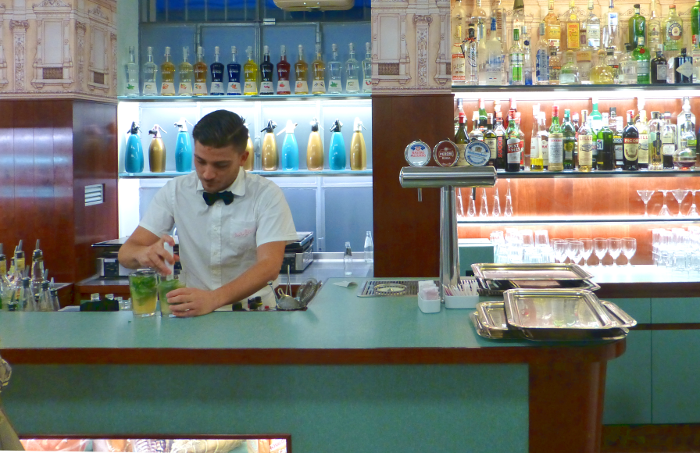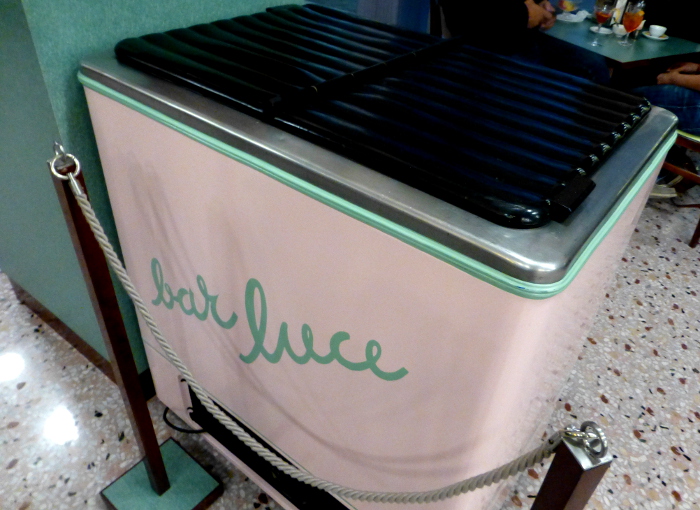by Jason Toon
Fondazione Prada had to know what they were getting when they asked Wes Anderson to design the cafe at their new museum and exhibition space in southeastern Milan. Every detail of Bar Luce is planned to evoke the midcentury mood and aesthetic of Italian Neorealist cinema. Anderson specifically cites Vittorio De Sica's Miracolo a Milano (1951) and Luchino Visconti's Rocco e i suoi fratelli (1960) as inspirations for a bar that "would make a pretty good movie set, [but] an even better place to write a movie." I was eager to see how well he succeeded...
Fondazione Prada had to know what they were getting when they asked Wes Anderson to design the cafe at their new museum and exhibition space in southeastern Milan. Every detail of Bar Luce is planned to evoke the midcentury mood and aesthetic of Italian Neorealist cinema. Anderson specifically cites Vittorio De Sica's Miracolo a Milano (1951) and Luchino Visconti's Rocco e i suoi fratelli (1960) as inspirations for a bar that "would make a pretty good movie set, [but] an even better place to write a movie." I was eager to see how well he succeeded...
From the terrazzo floor (above) to the stylish but not terribly comfortable "sofas" (below), the elements of Bar Luce are as unified as you'd expect from the meticulous director, harmonizing Old World decorativeness and midcentury streamlining into a distinctive whole. The only concessions to time are a few discreet USB outlets for customers to recharge their phones, and free WiFi (a very welcome innovation in a town where WiFi can be hard to find).
The drinks and food were also meticulously true to Anderson's recreation of a classic Milanese cafe: a wide range of aperitifs and simple but expertly mixed cocktails, and fresh sandwiches grilled in a traditional panini press. No agave-melon-peppercorn margaritas or microwave cheeseburgers here.
If anything, it started to feel a little too meticulous. The cafes where I had my morning coffee in Milan also had the requisite wall of liquor, the chestnut woodwork, the fresh baked goods. But they were also the kind of place where a painted-up matron in a pink tracksuit might leave her cigarette burning on the patio to step inside and buy lottery tickets. Along with their Milanese style, they had the messiness of real life.
And as you might expect from Wes Anderson, some of the touches skirted the boundary of cutesiness. These apothecary jars full of candy look great, but I can't imagine they sell much of it.
Also, inevitably, Bar Luce has become something of a pilgrimage site for Wes Anderson fans. I can hardly complain about that - that's why I was there myself. But on this particular evening, the place was crowded with Americans taking pictures. (Again, like me. No way I was gonna pass up a shot of the Steve Zissou pinball machine.) Most Milan cafe-goers don't have to dodge weirdos like me taking pictures of the ice-cream freezer. But then, most ice-cream freezers don't look this good.
And that's sort of the point. Like Wes Anderson's movies, Bar Luce is an exquisite visual confection that mixes the authentic, the archaic, and the imaginary into an experience that stands at a slight angle to real life. It's not where you'd go to soak up the flavor of Milanese life. But as an art installation where you can also get a good Aperol spritz, it's worth the visit.
And for such an obvious destination, Bar Luce's "outdoor signage" is pretty funny. Here it is in its entirety. Look for it when you're in Milan.
For your own box of European style, delivered to your door every month, subscribe to Eucopia today. Our premiere box ships in October.









 RSS Feed
RSS Feed